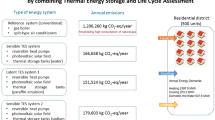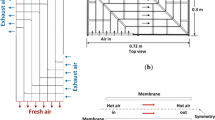Abstract
Ventilation system with thermal energy storage (TES) using phase change materials (PCMs) can be employed to save energy in buildings, which stores outdoor coldness in the PCMs at night and releases this energy to cool down the fresh ventilation air during the daytime. However, its performance depends on the design parameters. This paper presents a detailed parametric analysis to address the separate effect of each design parameter on the cooling energy supply and net electricity saving of the TES system against a conventional ventilation system for the climate of Beijing, by using a computational heat transfer model. A genetic algorithm (GA) is used to optimize the design parameters for maximizing the net electricity saving in four cities of China. The decision variables are related to the PCM melting temperature, PCM slab thickness and cold charging airflow rate. The results show that the saving-optimal solution is not unique and depends on the climate. GA optimization increases the net electricity saving by 10%–54%, with a mean value of 31%. Sensitivity analysis of net electricity saving to the above three variables is carried out. Likewise, the sensitivity of each variable is not unique and depends on the climate.
Similar content being viewed by others
References
Borderon J, Virgone J, Cantin R (2015). Modeling and simulation of a phase change material system for improving summer comfort in domestic residence. Applied Energy, 140: 288–296.
Chipperfield A, Fleming P, Pohlheim H, Fonseca C (1994). Genetic Algorithm Toolbox: For Use with MATLAB; User's Guide (version 1.2).
China Meteorological Bureau (2005). China Standard Weather Data for Analyzing Building Thermal Conditions, Beijing: China Architecture and Building Press. (in Chinese)
Cai Z, Long T (2009). Fluid Mechanics Pump and Fan, 5th edn. Beijing: China Architecture and Building Press. (in Chinese)
Cheng R, Wang X, Zhang Y (2013), A novel method to determine energy efficient mechanical ventilation strategy for active buildings. Journal of Engineering Thermophysics, 34(5): 935–937. (in Chinese)
Chen X, Zhang Q, Zhai Z (2016). Energy saving potential of a ventilation system with a latent heat thermal energy storage unit under different climatic conditions. Energy and Buildings, 118: 339–349.
Darzi AAR, Moosania SM, Tan FL, Farhadi M (2013). Numerical investigation of free-cooling system using plate type PCM storage. International Communications in Heat and Mass Transfer, 48: 155–163.
de Gracia A, Navarro L, Castell A, Cabeza LF (2015). Energy performance of a ventilated double skin facade with PCM under different climates. Energy and Buildings, 91: 37–42.
Kolokotroni M, Aronis A (1999). Cooling-energy reduction in air-conditioned offices by using night ventilation. Applied Energy, 63: 241–253.
Kang Y, Jiang Y, Zhang Y (2003). Modeling and experimental study on an innovative passive cooling system—NVP system. Energy and Buildings, 35: 417–425.
Michalewicz Z (1996). Genetic Algorithms + Data Structures = Evolution Programs, 3rd edn. New York: Springer.
Medved S, Arkar C (2008). Correlation between the local climate and the free-cooling potential of latent heat storage. Energy and Buildings, 40: 429–437.
Mosaffa AH, Farshi LG, Infante Ferreira CA, Rosen MA (2014). Energy and exergy evaluation of a multiple-PCM thermal storage unit for free cooling applications. Renewable Energy, 68: 452–458.
Osterman E, Tyagi VV, Butala V, Rahim NA, Stritih U (2012). Review of PCM based cooling technologies for buildings. Energy and Buildings, 49: 37–49.
Ravagnani MASS, Silva AP, Arroyo PA, Constantino AA (2005). Heat exchanger network synthesis and optimisation using genetic algorithm. Applied Thermal Engineering, 25: 1003–1017.
Shen Z, Zhu Z (1986). Discussion of formula of fraction factor in transitional zone. Gas & Heat, 6(1): 11–16. (in Chinese)
Srinivas M, Patnaik LM (1994). Adaptive probabilities of crossover and mutation in genetic algorithms. IEEE Transactions on Systems, Man, and Cybernetics, 24: 656–667.
Santamouris M, Sfakianaki A, Pavlou K (2010). On the efficiency of night ventilation techniques applied to residential buildings. Energy and Buildings, 42: 1309–1313.
Sun X, Zhang Q, Medina MA, Liu Y, Liao S (2014). A study on the use of phase change materials (PCMs) in combination with a natural cold source for space cooling in telecommunications base stations (TBSs) in China. Applied Energy, 117: 95–103.
Sun X, Zhang Q, Medina MA, Liao S (2015). Performance of a free-air cooling system for telecommunications base stations using phase change materials (PCMs): In-situ tests. Applied Energy, 147: 325–334.
Turnpenny JR, Etheridge DW, Reay DA (2000). Novel ventilation cooling system for reducing air conditioning in buildings. Part I: Testing and theoretical modeling. Applied Thermal Engineering, 20: 1019–1037.
Turnpenny JR, Etheridge DW, Reay DA (2001). Novel ventilation system for reducing air conditioning in buildings. Part II: testing of prototype. Applied Thermal Engineering, 21: 1203–1217.
Takeda S, Nagano K, Mochida T, Shimakura K (2004). Development of a ventilation system utilizing thermal energy storage for granules containing phase change material. Solar Energy, 77: 329–338.
Voller VR (1990). Fast implicit finite-difference method for the analysis of phase change problems. Numerical Heat Transfer, Part B: Fundamentals: An International Journal of Computation and Methodology, 17: 155–169.
Vakilaltojjar SM (2000). Phase change thermal storage system for space heating and cooling. PhD Thesis, University of South Australia, Australia.
Wang H (2007). Ventilation Engineering. Beijing: China Machine Press. (in Chinese)
Wang J, Jing Y, Zhang C (2010). Optimization of capacity and operation for CCHP system by genetic algorithm. Applied Energy, 87: 1325–1335.
Waqas A, Kumar S (2011a). Thermal performance of latent heat storage for free cooling of buildings in a dry and hot climate: An experimental study. Energy and Buildings, 43: 2621–2630.
Waqas A, Kumar S (2011b). Utilization of Latent Heat Storage Unit for Comfort Ventilation of Buildings in Hot and Dry Climates. International Journal of Green Energy, 8: 1–24.
Yao R, Li B, Steemers K (2005). Energy policy and standard for built environment in China. Renewable Energy, 30: 1973–1988.
Yang L, Li Y (2008). Cooling load reduction by using thermal mass and night ventilation. Energy and Buildings, 40: 2052–2058.
Zhang Y, Zhou G, Lin K, Zhang Q, Di H (2007). Application of latent heat thermal energy storage in buildings: State-of-the-art and outlook. Building and Environment, 42: 2197–2209.
Zhou D, Zhao CY, Tian Y (2012). Review on thermal energy storage with phase change materials (PCMs) in building applications. Applied Energy, 92: 593–605.
Acknowledgements
This work was supported by the International Science and Technology Cooperation Project of China (2017YFE0105800), the National Natural Science Foundation of China (No. 51878254), the Natural Science Foundation of Fujian Province, China (No. 2019J01776), and the Research Foundation of Education Bureau of Fujian Province, China (JT180319).
Author information
Authors and Affiliations
Corresponding authors
Rights and permissions
About this article
Cite this article
Chen, X., Zhang, Q., Zhai, Z. et al. Optimization and sensitivity analysis of design parameters for a ventilation system using phase change materials. Build. Simul. 12, 961–971 (2019). https://doi.org/10.1007/s12273-019-0536-2
Received:
Revised:
Accepted:
Published:
Issue Date:
DOI: https://doi.org/10.1007/s12273-019-0536-2




